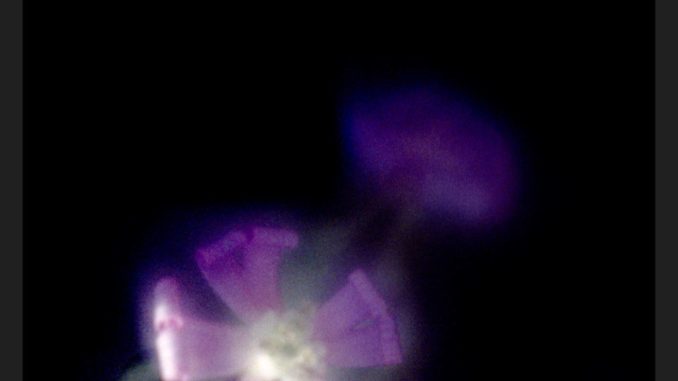
Flower photography at the Costa Blanca, Spain
With film, Canon F1 New and an oooold Petzval lens!
By Dirk Dom
Hi!
My true passion is flower photography. About three years ago I adapted a 100+ year old Petzval lens (about 150mm focal length and f/5.6) to my digital Olympus PEN and my 1980’s Canon F1 by putting it on an FD extension tube through a bronze tube which I machined. I photograph flowers with it. I use more FD extension tubes (50, 20 and 12mm) to get closer. The combo weighs about five pounds!
I switched back to film five years ago; the results are (to me) beautiful and often totally unexpected in texture, grain and colors. Film is also vastly cheaper than digital: I use great camera’s which I buy at maybe 5% of what they initially cost.
The Petzval is a very difficult and annoying lens. It has a mind of its own. It’s very soft focus and often I just can’t get it focused. What I see in the Canon F1’s viewfinder isn’t at all what I get on my negative. This has been extremely frustrating, and three times already, I ‘ve almost sold this lens. But the results I sometimes get make me keep on photographing with it. Maybe I’ll be able to control it in a few years.
I shoot Fuji Superia 800 color negative film for its texture, colors and grain. At f/5.6 and 1/1000 I overexpose about three stops in the sun, but color negative film easily handles that. It just doesn’t burn out.
This two week stay there weren’t many flowers yet because the weather had been cold. I went on long walks, ten to nineteen miles a day. I took about 180 flower photographs, five films, $55 including developing. I had 15 keepers.
Now, here ‘s some results!
There are millions of flowers and hundreds of millions of flower shots. So boooring!!! I didn’t really bother with ordinary compositions. This is one is an exception, with it’s nice composition and colors.
–
Thyme. A great mess of 3/8th inch flowers. I’ve been photographing it for years but just can’t get a decent shot as beautiful compositions are impossible. This is a nice one.
–
Lavender, against the sky, backlit, later in the day. See how film captures the golden light?
–
I only shoot wild flowers. This little one showed up in my parent’s garden about five years ago and has been multiplying, behind the flowers there is a spot of sun. This shot was so delicate and low contrast I had to restart post processing seven times to get it right and not destroy it.
–
With the Canon Speedfinder, which swivels up 90 degrees, I can shoot at ground level and see the viewfinder image. It shows the entire image from 2 ½ inch eye distance.
–
Taken angled upwards from ground level.
–
A little leaf of grass ends in ½ inch of red. It caught my eye and I wasted a shot on it. To my surprise it came out nice! What I saw in the viewfinder was totally unlike what I got on film.
–
Buttercups, very ordinary flowers which I just love.
–
Sun Roses, another favorite flower of mine. Difficult to get them into a nice composition because they are always so close together. This shot perhaps isn’t real beautiful, but I like it because it shows such a variety of colors and textures. Film renders shadow blue!
–
Garlic.
–
This little flower was in deep shade, lit by a small ray of sun.
–
Dry flowers from the year before are often fascinating.
–
This is a typical Petzval one: The unsharp dry flower in front came out totally unexpectedly.
–
This Spurge (Dutch: wolfsmelk) shot came out as a complete surprise. I took it on a building lot with a mess of weeds, you ‘d not look at it or think about going on it because there was nothing beautiful. This photograph shows how nicely blue film renders shade.
–
Well, these were the good photographs.
I realize that these may look kitschy, but this is what I love photographing.
Scanning the negatives after I get the film back is perhaps the most pleasant part of it: Then I see all the potential opening up!
Hope you enjoyed it,
And…
Waste some film!!!
Dirk.

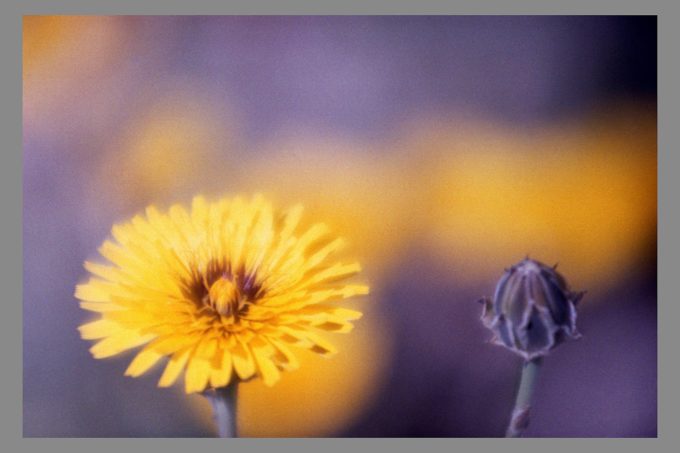
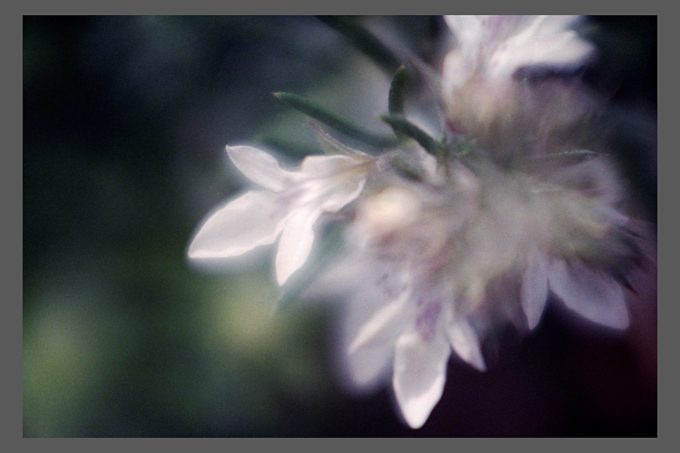
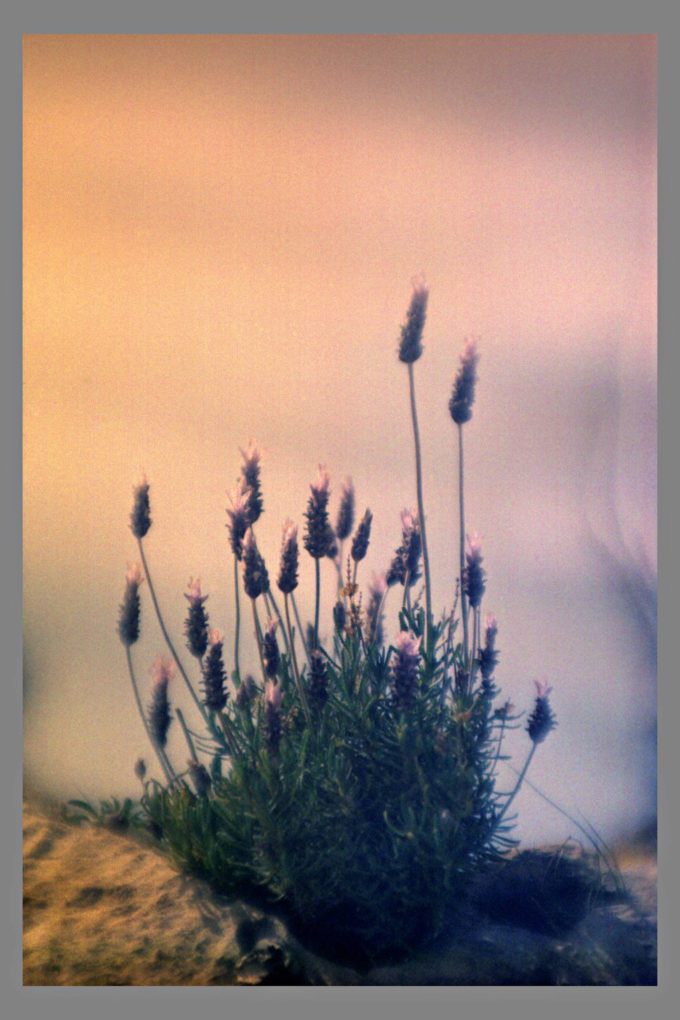
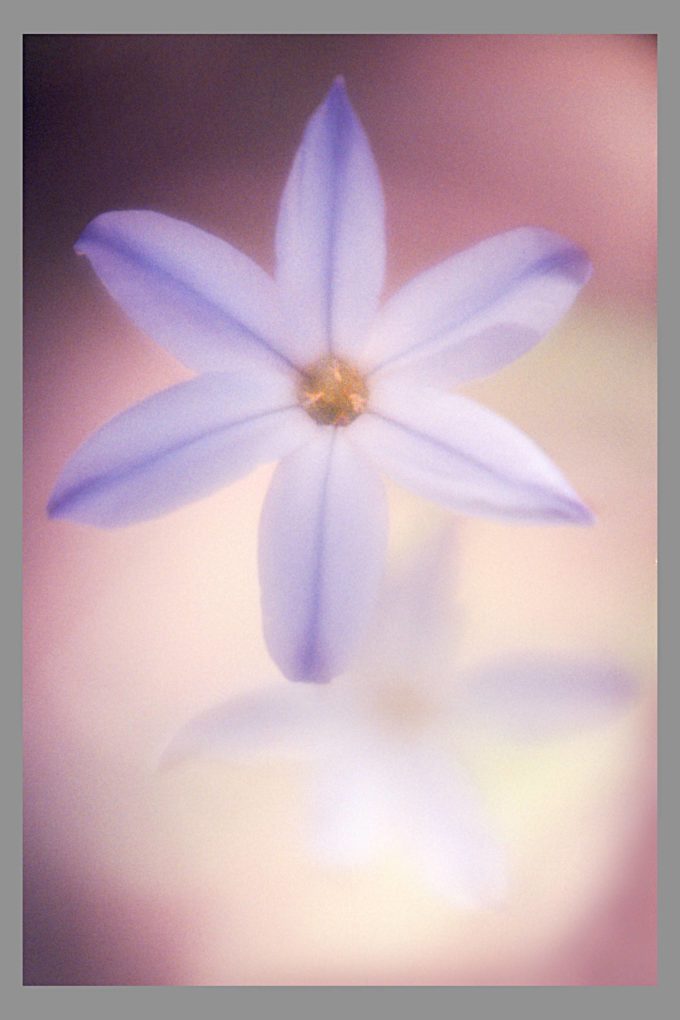
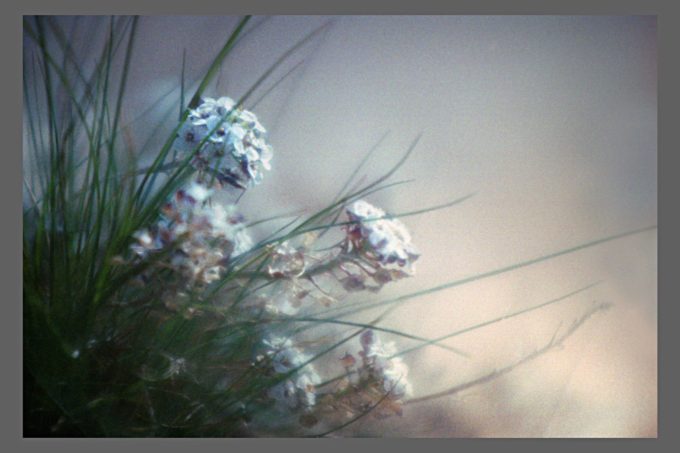
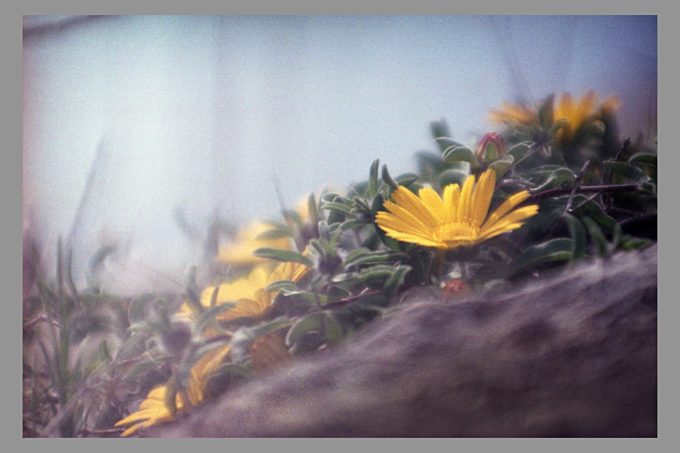
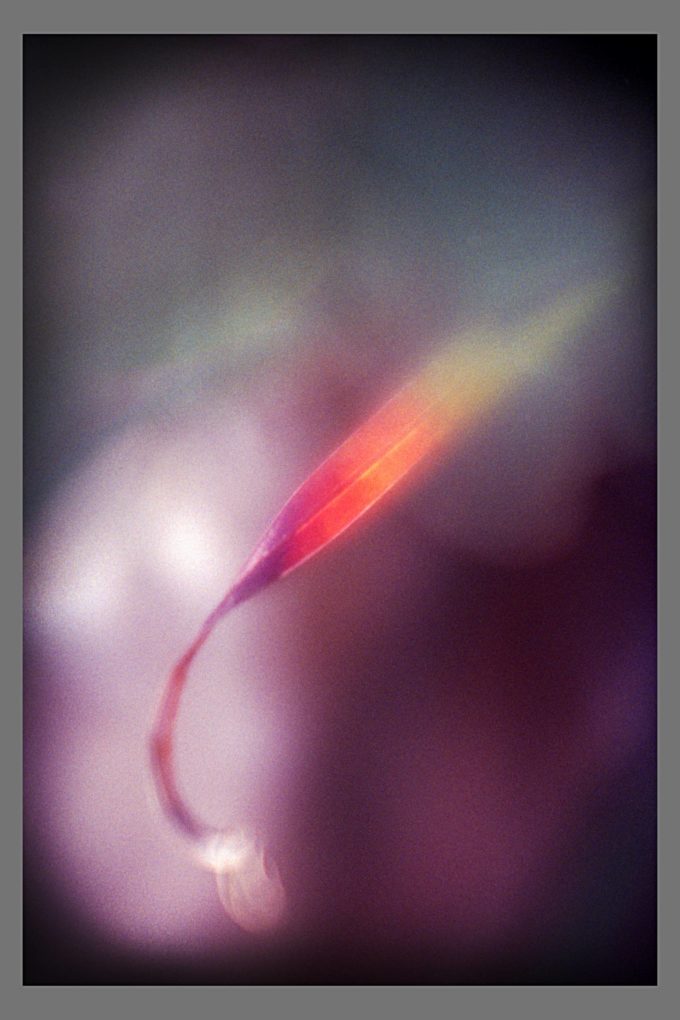
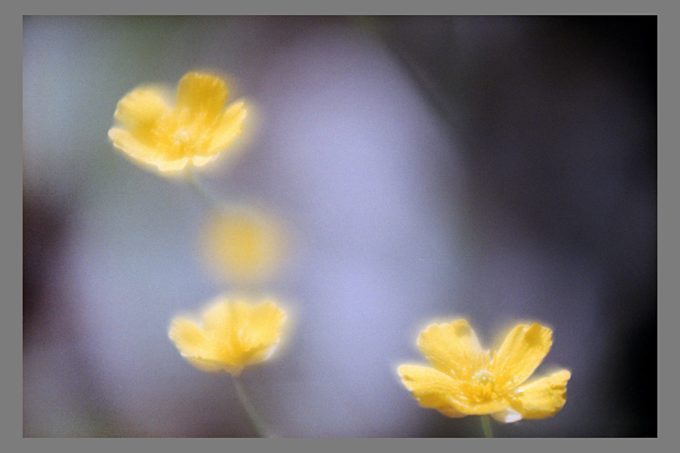
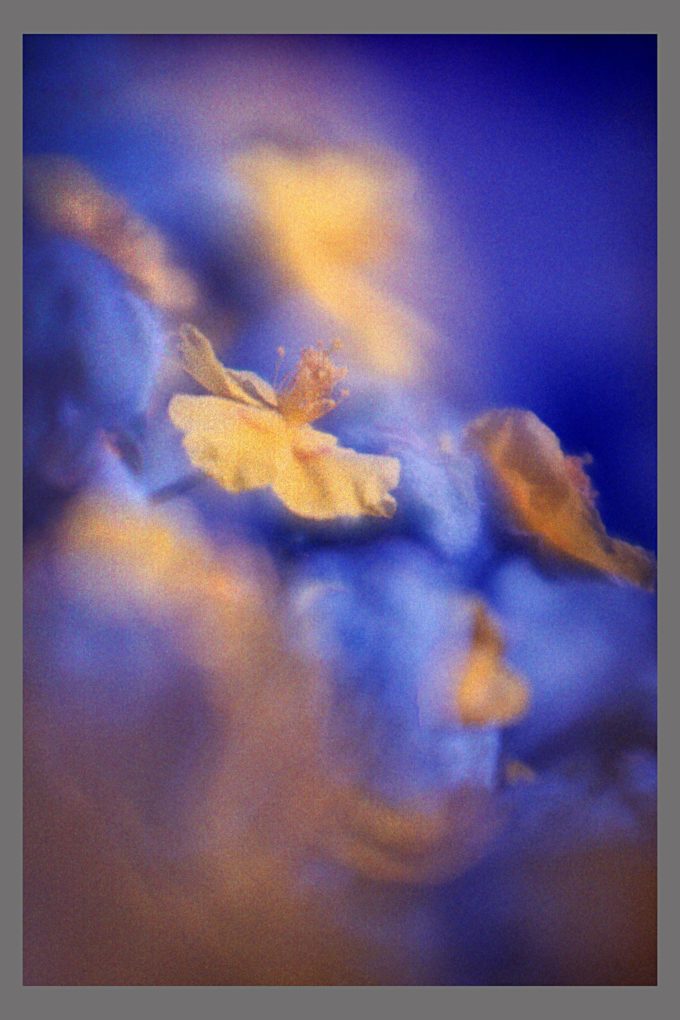
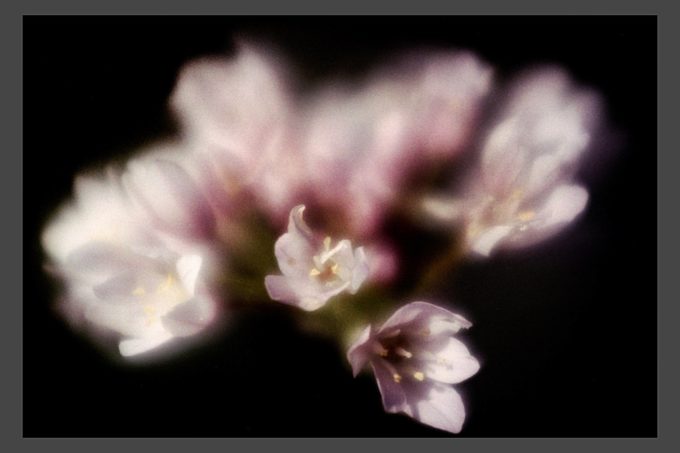
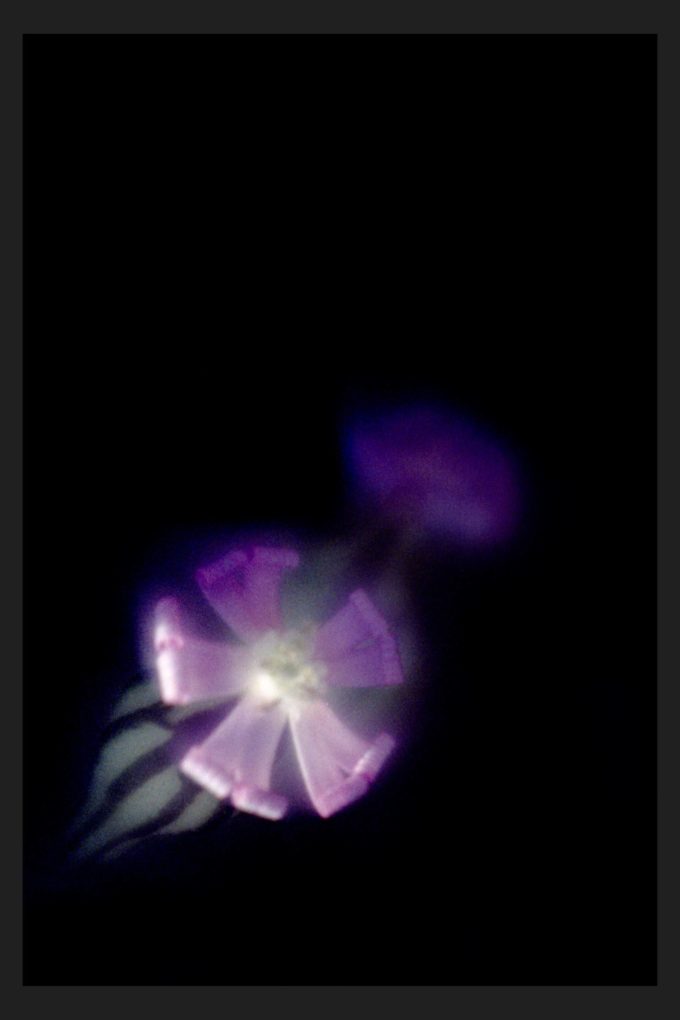
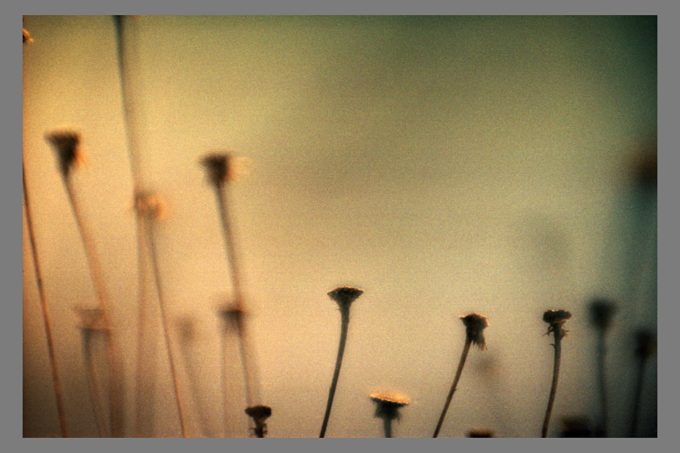
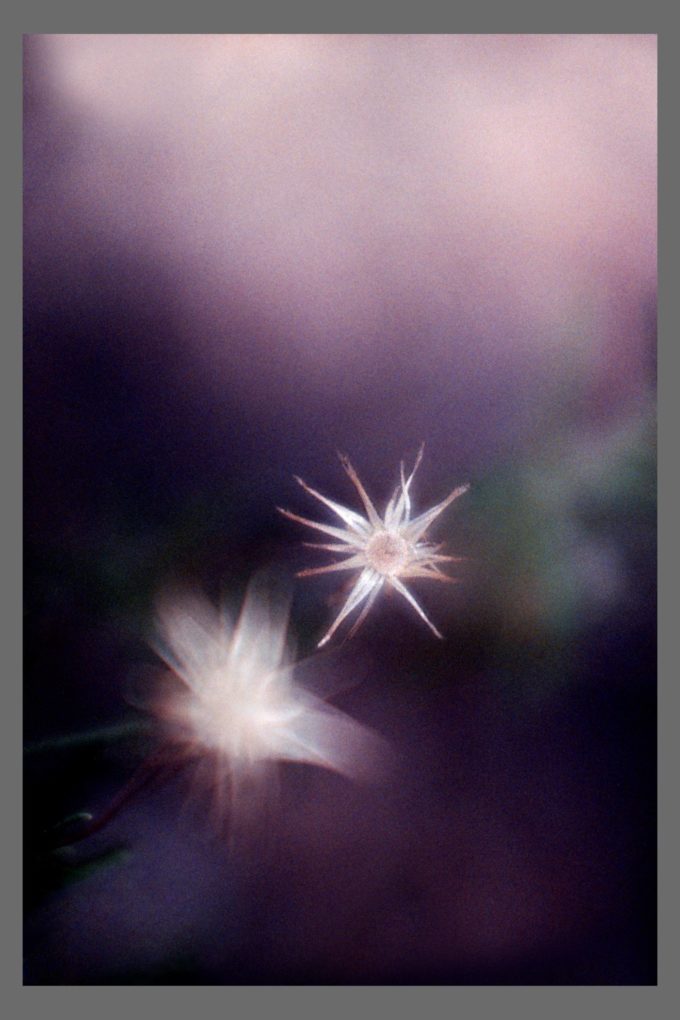
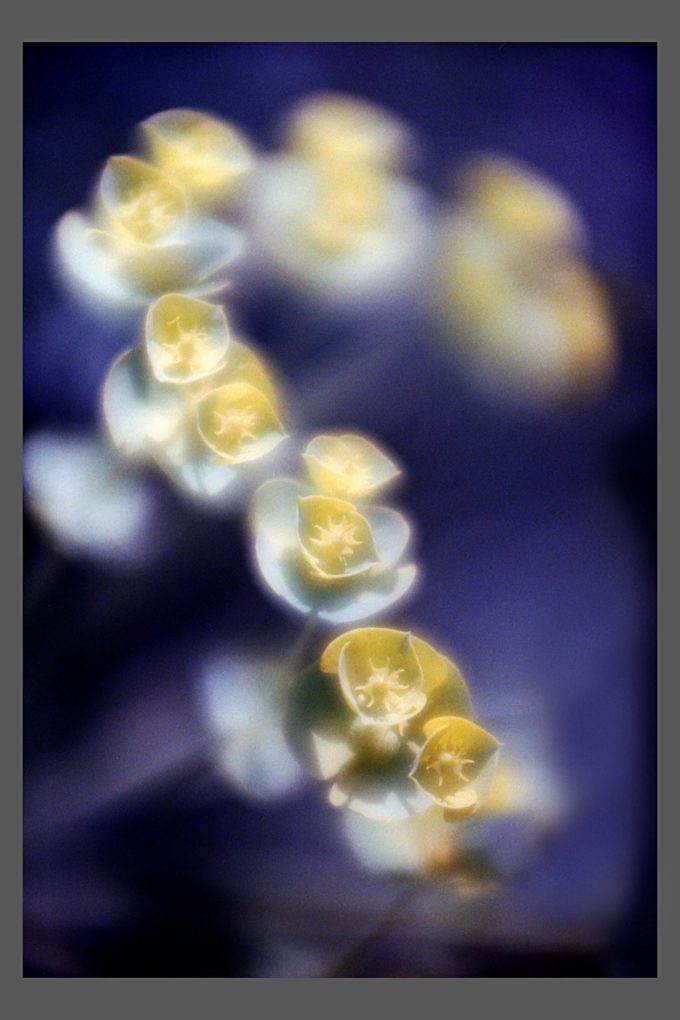


Dirk
These are amazing – beautiful beautiful photographs with gorgeous texture light and colour
I love film too – have you invested in a good 35mm slide projector ? I can imagine how these would look projected on a white screen if shot with slide film
Hi!
Yes, used lots of Velvia on flowers in medium format (6×6) with a twin eye reflex (Mamiya C330) The colors are stunning and of course no grain at all.
With Velvia you need a good light meter.
I used a Pentax spotmeter, if there were highlights, I overexposed those one and a half stop. Two stops overexposure makes them burn out on Velvia.
Bye,
Dirk.
Dirk, I am not really a “flower” guy, but you have inspired me with these photographs. I could see each and every one of them hanging in an art gallery! Really well done. My favorite film in the old days was Fuji Velvia (ASA 50)…remember that film?? I used it mostly underwater, but I think it would be great for flower photography…?? I have no idea if you can still get Velvia, but have you ever tried it for flowers?
Hi!
I scanned at 4800 PPI, some 30 megapixel, large enough for a 24 inch print at 300DPI.
Dirk.
hi!
I took perhaps 30 shots of sun roses and all were with too many flowers in it and not beautiful.
This shot had something but it lacked punch. The flower I triple sharpened very delicately and I gave it just a little bit of color saturation.
The Wolfsmelk was just a lucky shot. I think it’s one of the best I ever made. It comes from an empty building lot. it shows you don’t need to go to exotic places to make nice photographs.
I have printed the shots 1é by 18 inches, look nice! One should always print.
Thanks for your comment,
Bye,
Dirk.
Sun Rose and Wolfsmelk
Those 2 are my favs
I imagine them super-large on a wall
Photography as an art..not just an accurate reproduction
That’s what is awesome about your images
Hi, Lee!
I’ve never used a tripod in photographing flowers. I think it interferes with finding the nicest possible composition. I also often shoot at ground level and from there even upwards to get some blue sky.
Tripod photography makes accurate focusing easier. If there’s wind, you’ll get motion blur at too slow a shutter time , tripod or not.
Often i hold my breath for a long time.
To avoid motion blur, I shoot at at least 1/250th of a second. I’ve never used film or digital below 400 ASA, digital often up to the limit of what noise allowed. I rarely go beyond f/8 or f/11 stopping down.
This lens can’t be stopped down, I use it wide open, it’s about f/5.6 and some 150mm.
With my technical camera, to be as close to the ground as possible, I mounted a ball head on a wooden panel of about 8 by 15 inches and put one inch stubs below it in the corners. That way I can photograph with the lens about ten inches from the ground.
Bye,
Dirk.
Well, the old site there were 50 complaints a day about slow load, and issues. Ever since this version, 98.5% have said it is MUCH faster and better. So I have to go with what you guys tell me ; ) It’s fast, loads quick, and is easy to navigate. I have tested it with all browsers, and windows and Mac. Never an issue that I have found or seen. Mobile version the same. Thanks.
My goodness they’ are each fine art. And, beautiful photographs.
My question is did you need to use a tripod?
Thank you for taking the time to reply,
With respect
Sorry steve, I have to slay I agree with John Nicholson, the new site doesn’t rock as the older and is often a pain to load
Hope you’ll fix it 😉
Thanks to let us see so interesting work !
Thanks Dirk
Hi Dirk
I think I will give Lomography Color Negative 800 a try. It is available in packs of three films at a very good price indeed and has some decent positive reviews around the web – there’s a good one on emulsive.org for example. I once tried Kodak Portra 800, it’s a lovely film but I found it too fine grained for my purposes funnily enough and way, way too expensive for my pocket anyway.
By the way, I hear Kodak are reintroducing Tmax 3200 which is good news.
Best Regards
Neil
Well, have about 15 films left. They say 800 will remain available in 24 exposure rolls.
I could shoot Superia 400, but it has only half the grain of 800, so a large part of the texture which makes this kind of photography so beautiful would be gone. I may be the only one in the world doing this, overexposing 800 ASA film by three stops, so making this film just for me… Of course there must be more people loving high ASA film.
Tomorrow I’ll go to my supplier and buy their remaining stock, if they have some left. I looked on the Ebay, not much available and very expensive. Unfortunately I’m very low on money, being just retired.
Maybe in a few years they’ll make it again.
About 15 years ago, there was this Agfa Ultra 50, which was like a dream come true for architecture, it had unbelievable color saturation and inside churches etc it gave incredible colors from the light coming through the stained glass windows, just soaking up all the delicate color. The film was discontinued and I simply stopped shooting inside churches. Maybe I should try to restart it with Kodak Ektar? But that film is totally different.
And I’m down to my last six rolls of Kodak Tmax 3200, which I think, exposed at 400, yields fantastic results, it has a kind of force and crispness Tmax 400 just doesn’t render. But in black and white, there are lots of options which I haven’t tried out yet. I’d like to stick with what I know, though.
Bye,
Dirk.
What gorgeous photographs, I love the colours, the grain and the delicate rendering of light. What will you do when you run out of Fuji Superia 800 film stock?
I too love using Fuji Superia 800 film for its colours and grain, but my stock which I hoarded when they discontinued it here in Europe a good while back is running low (I am down to my last four films) and there are no more to be had from my usual dealers. So it is the end of an era sadly.
fascinating results. nice work. I love flower shots. I would love it if steve would revisit macro attempts with the m10 and leica macro adapter on flowers. or, even compare results with the x1d. It is fascinating to see the film results and compare against so many of us quibbling over modern digi sensors.
On my three macs it is smooth as silk, as well as on my Android tabs and PC. So doesn’t seem to be an issue with the site itself.
Agreed, Steve, it shouldn’t, and your older version never did. And this is the only site which does it on my Mac. Can’t think why. And it’s still a good site and I shall go on vsiiting. All the best.
Hi!
I’ve been shooting flowers with black and white film, it can be beautiful.
I’ve done solarizations of flower shots both in black and white and color from digital. I had a post about it here on this website. I use the solarization filter of Photoshop. It renders into lines and such, and you can (after merging the layers) solarize more than once. You need a very simple, strong image for it.
Bye,
Dirk.
Hmmm. I have yet to have it freeze any of my devices or computers. Shouldn’t do that!
Hello, Dirk,
I very much appreciate your comment.
When I stopped using film ten years ago, a big reason was that the 400 ASA film I used didn’t have enough “megapixels”. I had no idea at all about the medium “film”.
About five years ago, I was photographing flowers with a macro lens and a digital camera. It got so boring and predictive that I stopped it for a year. I restarted using 800 ASA film to get grain and the Canon FD 85mm f/1.2 with extension tubes and ND filters wide open, when I realized you can overexpose color neg film four stops and still get very printable results. Color negative film is an incredible medium.I started using the Petzval, which cannot be stopped down, with 800 ASA film. Flower photography became interesting again.
My percentage of keepers is 7%, and I love that.
I’ve learned that film and digital are two very different media. The “megapixels” of film don’t matter, texture matters, at least for me. I think it makes no sense emulating film from digital. But I learnt a lot in the five years I shot digital.
Abstracts and insects, I still shoot mainly digital because the very low percentage of keepers.
Of course you can get results which are accurately reproducible with film, too.
bye,
Dirk.
A very special experience, thank you. (I had to struggle to see them all because Steve’s new site constantly freezes my computer, but your posting was emphatically worth the struggle!) I also love photographing flowers and have two different ways of processing: either black and white (inspired by Imogen Cunningham’s work) or extreme definition and contrast so I end with something like a line drawing – both in colour and b&w versions. I don’t use film, but very much enjoy the effect with a low resolution camera – the Digilux 1 (4megapixels) and Digilux 2 (5 mp).
This certainly is no kitch to me, Dirk! The esthetics are simply too amazing!!
It really shows that flower photography is indeed your great passion. I simply can’t decide which picture I love the most. Take for instance the surprisingly beautiful last one. Or the delicacy of the one you processed seven times. Etc, etc.
All Petzval images? This is so beyond what we normally see from this lens! Simply gorgeous.
The weird thing to me is: I’m tremendously attracted and still your workflow is so far from mine. Where I normally try the picture to be as close as possible to what I imagine when taking it, you wait for and are allowing the surprise of what the medium produces and then get inspired while post processing. IMO that’s a method, equally valuable as mine, and often I get inspired too when processing – nothing wrong with that. But in this case, the pictures result in totally different final images from what you see. Using reality to create. Can we get any closer to art than that?
I can tell you, often, when looking at your pics, I feel the fever to reuse my film camera’s. Maybe one day. I’ll never sell them, that’s for sure, so who knows…
Hi!
I had a very old camera with about 12 x 15 inches plate size which I bought for an optics show. I put a 6 inch diameter, 300mm focal length magnifying glass on it. Completely open the image was not very sharp but interesting. Stopping down with a cardboard cut out circle of two inches diameter the image improved dramatically and was full of character.
perhaps all this technology of 25 element super lenses isn’t all that necessary?
Dirk.
thanks for such beautiful shots
Great work..
like it much
Charming – your posts are always different and fun, thank you!
Thanks for the photos Dirk, enchanting, mesmerising and ethereal. Truly beautiful.
Kitschy or not, I do like your flower pictures very much.- Many years ago a got technically compareable results using a selfmade lens made with a single meniscus with +10 diopters (close-up lens) resulting in 100 mm focal-length, attached to a bellows. Cheap and very effective with beautiful results. The soft-focus was variable via paper made apertures. I was very satisfied with this approach.